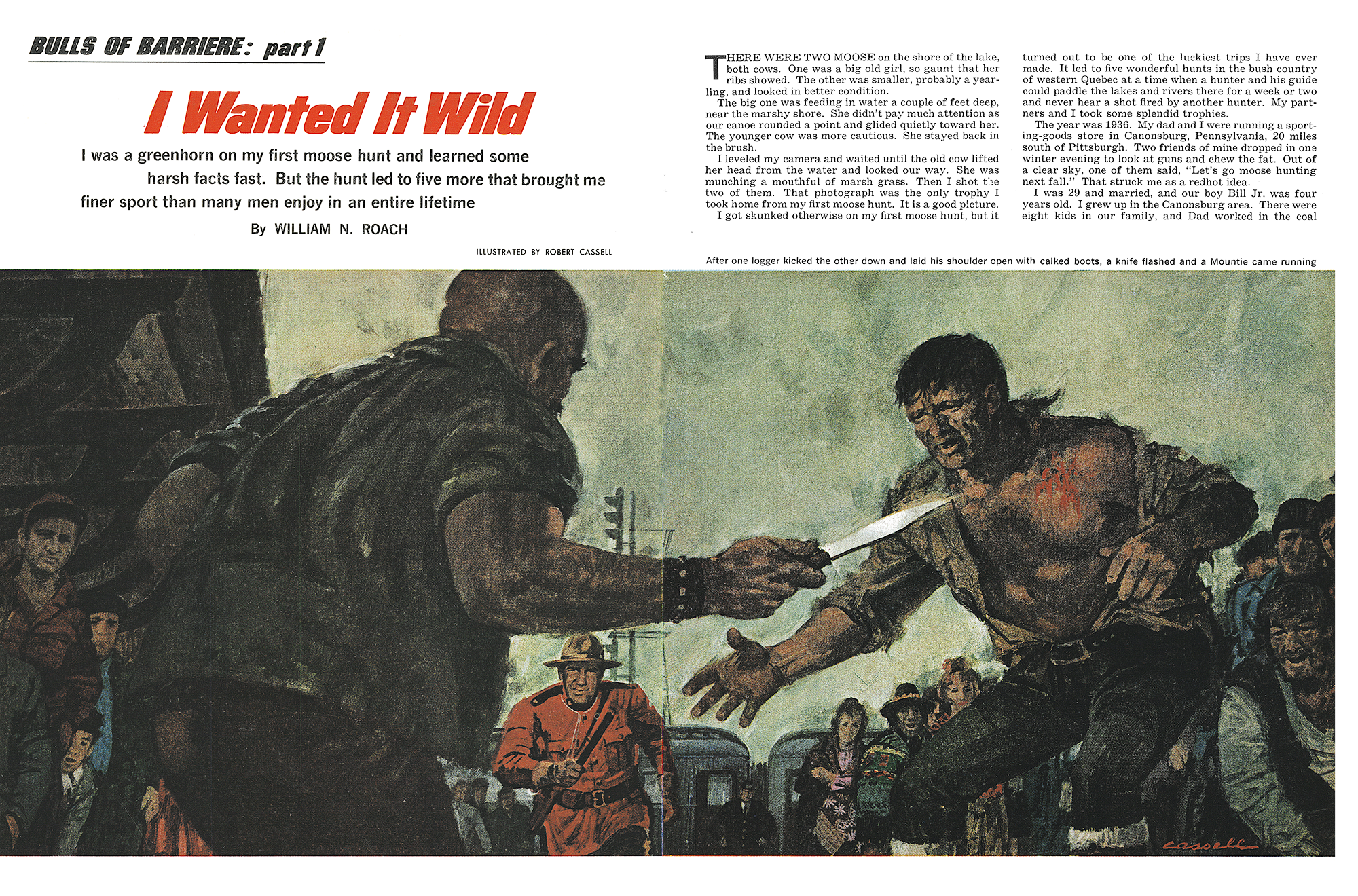This story, “I Wanted It Wild,” first appeared in the October 1971 issue. It’s the first of the author’s stories from a series of moose hunts.
THERE WERE TWO MOOSE on the shore of the lake, both cows. One was a big old girl, so gaunt that her ribs showed. The other was smaller, probably a yearling, and looked in better condition.
The big one was feeding in water a couple of feet deep, near the marshy shore. She didn’t pay much attention as our canoe rounded a point and glided quietly toward her. The younger cow was more cautious. She stayed back in the brush.
I leveled my camera and waited until the old cow lifted her head from the water and looked our way. She was munching a mouthful of marsh grass. Then I shot the two of them. That photograph was the only trophy I took home from my first moose hunt. It is a good picture.
I got skunked otherwise on my first moose hunt, but it turned out to be one of the luckiest trips I have ever made. It led to five wonderful hunts in the bush country of western Quebec at a time when a hunter and his guide could paddle the lakes and rivers there for a week or two and never hear a shot fired by another hunter. My partners and I took some splendid trophies.
The year was 1936. My dad and I were running a sporting-goods store in Canonsburg, Pennsylvania, 20 miles south of Pittsburgh. Two friends of mine dropped in one winter evening to look at guns and chew the fat. Out of a clear sky, one of them said, “Let’s go moose hunting next fall.” That struck me as a redhot idea.
I was 29 and married, and our boy Bill Jr. was four years old. I grew up in the Canonsburg area. There were eight kids in our family, and Dad worked in the coal mines. Money was always scarce, so I took on a paper route as soon as I was old enough.
My earnings weren’t exactly handsome, and nothing could be spared for the .22 my heart longed for. But I found a way to hold out some cash. Every now and then the paper put out an extra. When that happened, my income went up. I hoarded all the money I made from the extra editions, and when I was 12, I finally had enough to buy a Stevens single-shot .22. It was the first of a long line. Since then, I have owned as many as 50 guns at one time.
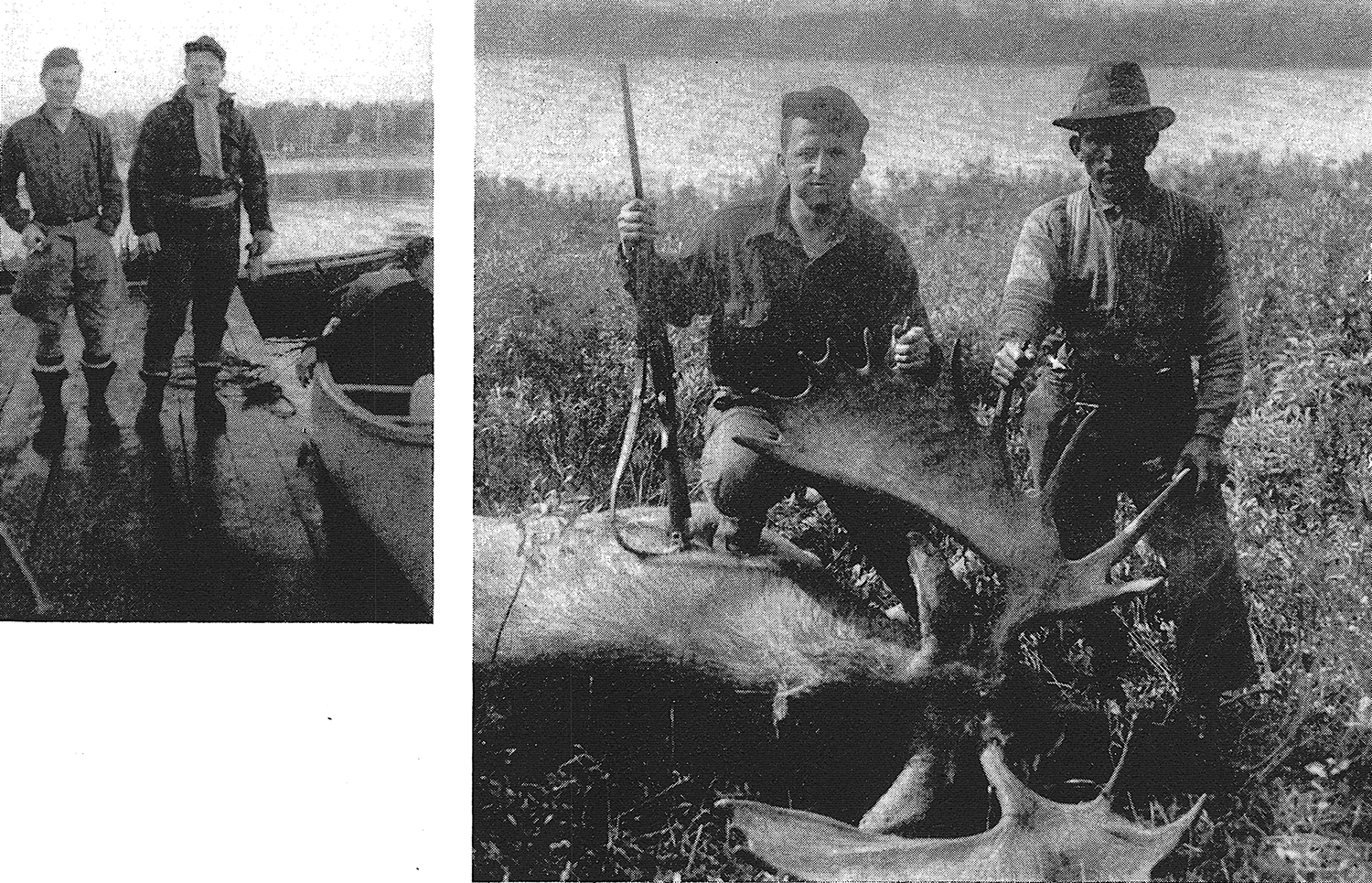
Three years later I bought a shotgun about the same way, and that fall I lied a year about my age and got the hunting license I coveted. I went on my first deer hunt in 1929. I took the train north to Renovo on the West Branch of the Susquehanna. By the time the moose hunt was proposed in 1936, I was an old hand at Pennsylvania deer hunting.
I decided at the outset that I wanted to go after moose in remote country where I could see trading posts and have things as much to myself as possible. I had made fishing trips into pretty fair moose country in eastern Ontario, but it hadn’t been wild enough to suit me. I started by writing the Canadian Travel Bureau for a list of outfitters and guides and finally decided on a hunt in Quebec.
I picked my outfitter partly because he had a son living nearby in Pennsylvania and I could visit him and discuss details. That proved to be the wrong way of going about it.
My two friends backed out of the hunt for one reason or another. No whit discouraged, I bought a pair of Hudson’s Bay blankets in place of a sleeping bag, packed my deer-hunting gear and a .35 caliber Model 14 Remington rifle, and climbed aboard a train at Pittsburgh.
I wanted it wild, and that’s what I got. At La Tuque, then a small station on the Canadian National north of Trois Rivières, our train hooked on two cars full of First Nations people, French-speaking lumberjacks, and a few draggled-looking girls. Just about everybody was drunk. I walked back through the train for a look, and one look was enough.
We pulled into the station at Parent early in the morning and stopped for a 15-minute layover. The train no sooner stopped moving than those two coaches emptied. The lumberjacks formed a circle around two of the meanest-looking characters I had ever seen. Both of them were full of firewater and fury.
They squared off like two gamecocks and used their feet rather than their fists. It came as a shock to me that both of them were wearing lumberman’s boots with sharp steel calks. Somebody was going to get hurt and badly too.
WITHIN SECONDS, one kicked the other down and laid a shoulder open with those calks. The man who was still on his feet did his best to get at his opponent’s face, but friends of the fallen man protected him until he could get up. They broke apart, and I saw the flash of a knife. At that instant, a Mountie in full uniform charged across the station platform. He swung his billy club once, the knife flew through the air, and its wielder went down.
The spectators scrambled for the two railroad cars. All of a sudden there were only three people left on the platform—the Mountie, the lumberjack, who lay there moaning with a broken arm, and a very wide-eyed greenhorn moose hunter. It didn’t take me a split second to decide that it was no place for me either.
I had shown the train conductor a letter from my outfitter that told me where to get off. Near Amos, about 60 miles east of Lake Abitibi, the train braked to a halt, I climbed down, and my baggage was tossed off. The train pulled out, and I was left standing there in what looked like 10,000 square miles of empty bush.
It was 15 minutes before my outfitter and guide showed up. He wasn’t a First Nation man, as I had expected. He grunted something in French, picked up my duffle, and motioned me to come along. We followed a trail for a quarter of a mile to the shore of a lake and then loaded my gear into a canoe for a three-mile paddle to a low-roofed log lodge and a group of cabins on a wooded island.
The guide and I started moose hunting the next morning. To my astonishment, the only items he put into the canoe were a burlap bag containing a few food supplies, a teapot, a skillet, and two pie tins, all in a cardboard carton—no tent, no blankets, no other camping gear.
“Where’s the camp outfit?” I demanded.
“Hunt from this camp,” he said shortly, jerking a thumb toward the lodge.
That exhausted his English vocabulary for a while. He did not speak another word until we went ashore for lunch. I can’t remember what we had to eat, but I know it was one of the poorest meals ever cooked over an open fire. At sundown we paddled back to the lodge for the night. I decided my guide was a fraud.
The same sort of thing went on for four days, and I did not see so much as a fresh moose track. We paddled in and out between islands and along the shores of boggy bays. The guide did no calling, and nothing bigger than a porcupine showed itself. I was doing a lot of canoeing, but you couldn’t call it hunting.
On the fifth morning, we blundered into the two cow moose and, I got my picture. After I snapped it, the guide backed the canoe away, and the old cow lifted her head and gave out with a series of moaning grunts. My heart started to thump. I was sure a bull would answer that pleading call, and I’d shoot him.
But nothing of the sort happened. We hung around for several hours. The cow bawled, grunted, and begged at intervals, but there was no reply. If there was a bull within hearing, he didn’t believe what she was telling him.
When we got back to the lodge, I laid it on the line with the outfitter. We had a firm agreement in writing. The trip was to cost me $150, of which I had sent him $25 as a deposit, and I had paid $50 more when I arrived in camp. The remaining $75 was due when he got me a shot at a bull moose of any size. If I missed, that was my hard luck.
I told him that he could either get me a guide who knew his business and send me where there were shootable moose, or he could return my $75 and take me out to the railroad.
He countered by offering to take me out at night and jacklight a bull. I turned that down. Next he said that the fault was mine since I was refusing to hunt.
Next morning, I packed my gear and carried it down to the dock. I was ready to leave. At that point, I got another jolt. The outfitter announced that he wouldn’t take me out until he had the rest of the $150. I reminded him again of the terms of our agreement.
“You’re quitting the hunt,” he growled. “You can pay up or sit here.”
I was stranded. I thought of helping myself to one of his canoes but wasn’t sure I could find my way to the railroad through the maze of islands. To pass the time, I got out a rod and started fishing. I made a few casts with a red-and-white spoon and landed a 12-pound northern pike. The lake must have been crawling with them.
About that time I spotted a man paddling by in a canoe and waved him in to the dock. I offered him a day’s pay to take me to the railroad, and he accepted in a hurry. But before we could load my gear, the outfitter came blustering down to the dock with a .30/30.
“You get the hell out of here,” he ordered the other man.
I walked over to my gear, uncased my .35 Remington and poked a couple of rounds into the magazine.
“Just go ahead and load up,” I told the man quietly. “I’ll take care of things.”
The outfitter started to argue, but when I put my face within a couple of feet of his, he looked down at my rifle, turned on his heel, and went back to the lodge. I was asked later what I really intended to do. I still don’t know, but I’m sure of one thing. I didn’t intend to be held prisoner on that island.
That was how I met Edouard Decoursay. He told me that he had been guiding for that fraud of an outfitter for $1.50 a day. He furnished his own canoe and was forbidden to share the client’s food. He had been given a limited supply of tea, sugar, bread, lard, and beans. If he wanted meat, he had to catch it or shoot it himself.
He had quit in disgust and was looking for a job—150 miles from home and broke. That was the reason he had risked paddling in to the dock when I beckoned him.
Before we reached the railroad, he had told me a lot about the area and about moose hunting. I wound up by engaging him to guide me the following fall. When I offered him the same $150 I had agreed to pay his former boss, Edouard was flabbergasted.
“Too much! Too much!” he muttered.
It turned out that I was getting a real bargain. I had hired one of the best guides and moose callers I’d ever meet.
When we talked about the outfitting arrangements, he simply said: “Write to Eric—Hudson’s Bay Company manager at Barrière. He take care of everything.”
ERIC TURNED OUT to be Eric Tutching, one of the finest men I have ever known. He could do anything the bush required.
I wrote him and got a prompt reply, even though his letter had to make its first lap by snowshoe. Eric became one of my best friends.
Born in England, he had studied medicine for two years in France. That training stood him in good stead in treating the sick among the First Nations who traded at his post. In one letter to me in the winter of 1939 he told of making a trip by dog team to visit two women who were ill.
“I was on my feet 34 hours and walked 34 miles on snowshoes,” the letter read, “but I have both my cases fixed up. I have not lost a patient since I came up here, thank God!”
He had shipped out to Canada as a Hudson’s Bay Company man for reasons he never mentioned. Eric died in a Canadian Air Force plane over the English Channel in World War II. I still cherish some of his letters.
Thinking about the next year’s hunt, I was happy all the way back to Pennsylvania that fall, although I was going home empty-handed. I stayed happy through the winter, in spite of the failure of my letters to the Canadian authorities to unsnag any part of the $75 I had paid the phony outfitter.
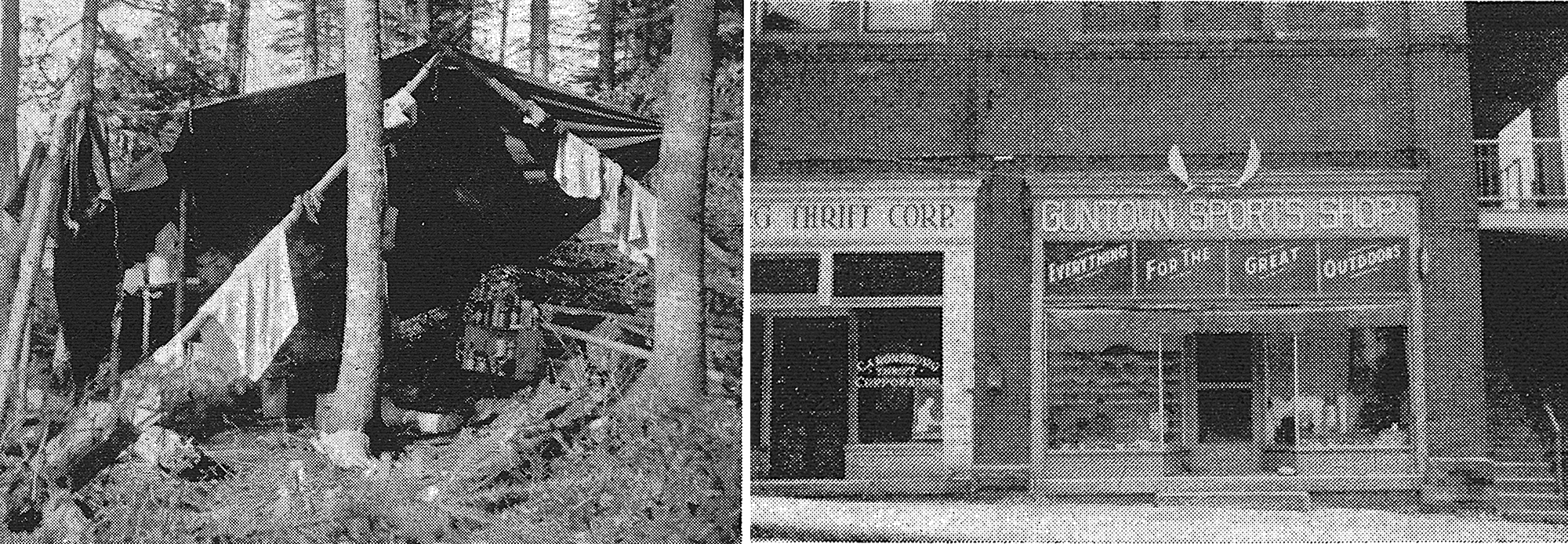
I CORRESPONDED with Eric regularly to complete plans and arrangements to the last detail. He sent me some good topographic maps of the Lake Cabonga district where I’d be hunting, and I spent a lot of time studying them.
Nobody wanted to go along, I suppose because I had been skunked on my first trip. But that didn’t bother me. I bought a new Winchester Model 70 in .30/06 with a Lyman peep sight and a Noske 4X scope with detachable mounts. I carried the scope in a scabbard.
I did a lot of target shooting that summer from a sitting position, the way I’d be in a canoe. When the time finally came, I loaded my deer-hunting gear, the new rifle, blankets, binoculars, and the rest of my outfit into a new car. I figured I had everything a hunter could ask for.
I was too excited to sleep the night before departure, so I finally took off at 3 o’clock in the morning. I napped in the car alongside the road now and then. By noon of the second day, I made it to Maniwaki, a hamlet at the end of anything you could call road. I was about 100 miles due north of Ottawa. I had driven 700 or 800 miles, and I put up at the hotel for some badly needed sleep. The place was plain but clean, with bare wooden floors well scarred by the calks of lumberjack boots. My room cost me $1.50 for the night.
At the general store, run by a grand old English gentleman, Foster Bennett, who was to become another good friend, I bought two slabs of bacon and a few odds and ends the next morning and got some advice about the drive ahead. The 60-odd miles of road to Hunters Point, a construction site where Edouard would meet me, wasn’t too good, Bennett said, but he thought it could be driven. It proved to be the roughest trip I have ever made.
It was a freight road, and mine was the first passenger car that had passed over it in months. I put chains on the rear end, and before I was through, I wished I had an extra set for the front wheels.
There was mud, rocks, and corduroy. I felled logs to patch holes in the bridges, cut brush to fill the sinkholes, and dug drains to let water off the road until every muscle in my body ached. I made the 60 miles in nine hours, and I’ve never been happier to arrive at any destination.
Edouard was waiting for me. We loaded my gear into his 18-foot hand made square-stern canoe and headed for the post at Barrière, 90 miles by water, pushed along by a nine-horsepower outboard.
It soon grew dark. I could barely make out the timbered shoreline and the many islands, but my guide followed the route as easily as if it had been a familiar paved road, and we made good time. I fell asleep, exhausted by my nine-hour drive, and was awakened by the sound of voices and the barking of small dogs. There were no howling huskies as I had expected. I learned later that Eric would not allow the First Nations’ sled dogs at the post. Too much wolf blood, he said.
I was stiff and sore all over, and some body practically lifted me out of the canoe. Eric hustled me up to his quarters and gave me a cup of hot tea laced with Hudson’s Bay high-proof rum.
I drank a second cup and fell into bed. The next thing I knew, Eric was asking me did I want one or two eggs for breakfast. I ate six plus ham and toast made from home-baked bread.
I spent the next day looking over the post. Everything about it fascinated me—the barrels of salt pork and fish, the flour, rolls of blanket cloth and calico, staple groceries, snowshoes, boots, traps.
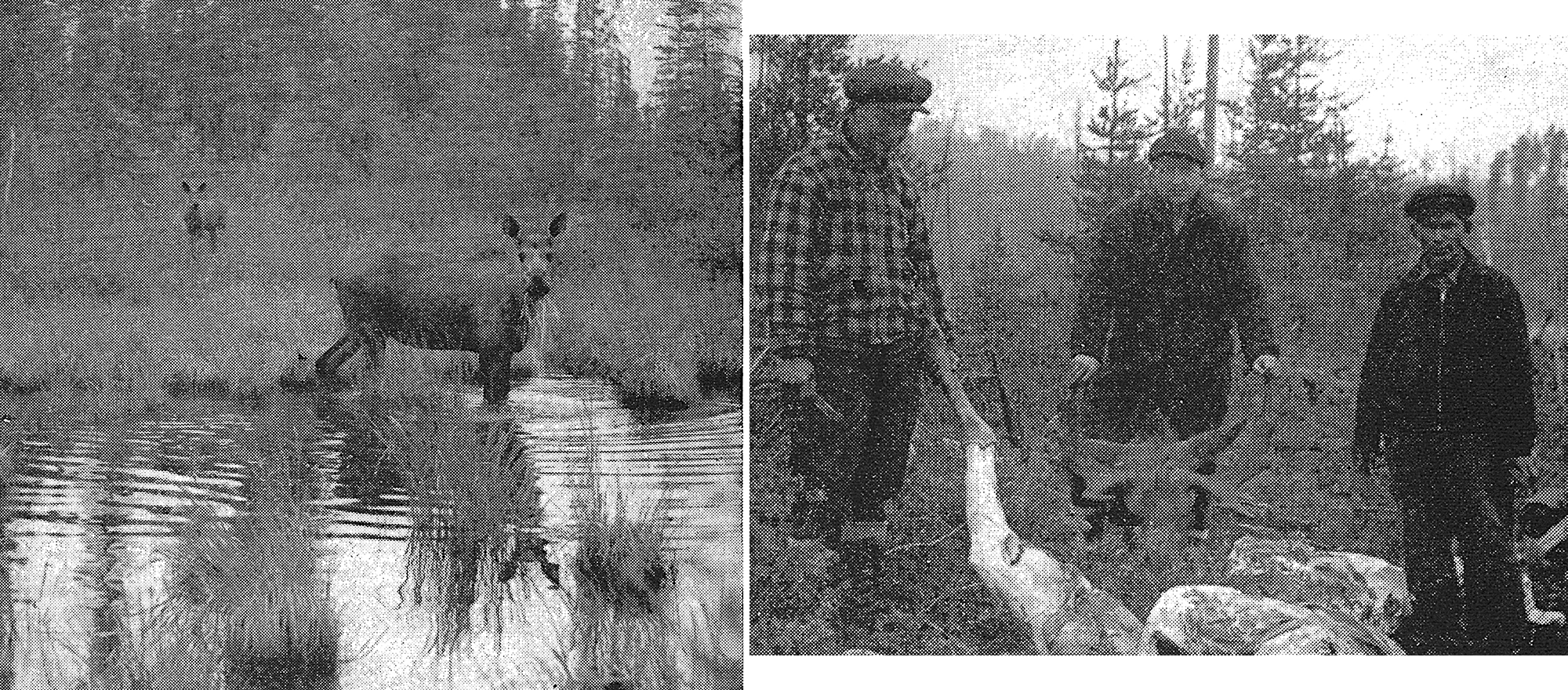
The First Nation village lay across a bay of Lake Cabonga, a man-made lake impounded earlier in connection with logging operations. I asked Eric about visiting the village.
“If they ask you,” he said quietly, “we’ll go, but I don’t think they know you well enough yet.” It took another year before I got that invitation.
After supper that night, Eric announced that we were going duck hunting. I couldn’t imagine duck hunting in the dark, but I asked no questions. Edouard and another of the post’s top guides, a First Nation man named Nona Manateh, piled into a big canoe with Eric and me, and we headed down the lake. The night was overcast and pitch black, and I didn’t have much hope for good hunting.
Eric explained that First Nations didn’t have to abide by the game laws. They could take whatever they could get for food in any way they wanted.
THE CANOE slipped along quietly, driven by two paddles, and soon I could hear the quacking and splashing of a raft of ducks somewhere ahead. The canoe slid on without a ripple of sound, then turned, quartering. The flashes of four shotgun shots split the darkness. The guides had cut loose with both barrels of their two 12 gauge doubles to rake the flock on the water.
We picked up dead ducks and chased cripples for an hour, and when we headed back, the canoe was lower in the water with the weight of 40 birds, mostly blacks. Eric kept enough for our supper the following night. We ate a duck apiece, cooked bush style-browned like a pot roast and then simmered in its own juices. I can’t remember a better meal.
I was awakened before daylight the next morning by piglike squealing and growling and the barking and yelping of the dogs. The din was terrific.
“There’s a bear after the cubs,” Eric yelled. We grabbed our rifles and a lantern and rushed outside.
Two bear cubs, weighing about 40 pounds apiece, had been confined in a heavy pole-and-wire cage behind the post buildings. The cage had been smashed open. One cub was kicking his last inside. The other had vanished.
“That was a big old boar,” Eric told me. “He carried the other cub off. We’re going to have to kill him.”
The dogs took after the bear, but within a minute there were yelps and ki-yis out in the brush, and they came flying back with their tails tucked between their legs.
At dawn we started after the bear. Edouard and Nona did a superb job of tracking even though they were lugging a bear trap about four feet long that had teeth like a shark’s, an ax, heavy wire, and a couple of jars of scent that consisted mostly of rotten fish entrails.
We trailed the bear for three miles and finally found what was left of the cub covered with woods litter. The boar had devoured most of him.
The men cut a heavy log for a drag and wired the trap to it. Next they laid scent trails out from the cub’s remains in several directions and sprinkled what was left over the mutilated carcass. They needed two poles to pry down the powerful springs of the trap. When it was set and all hint of man brushed out, they stood back and looked things over very carefully.
“Tonight for sure,” Edouard predicted, and Nona nodded agreement.
He was right. When we got back to the place shortly after daylight the next morning, it looked as though a bulldozer had torn things up. Brush had been flattened and saplings bitten off, and blood was spattered everywhere.
The bear had made off with trap and drag, but he had left a trail that even I could have followed. In several places where the 250-pound drag had tangled in the brush, it looked as though the bear had picked it up bodily and walked on with it.
We followed him a mile, and when we caught up, he was the fiercest-looking animal I had ever seen. He growled and popped his teeth. His eyes blazed, and froth flew from his jaws. I had my rifle, and the men invited me to shoot the bear, but I declined. I figured it was their show.
Edouard and Nona debated killing the bear with an ax—the drag was hung solidly this time and even egged each other on but finally decided against it. Nona took care of him with his .30/30.
I LEARNED LATER that the First Nations people at Barrière hated bears. They wouldn’t eat bear meat, and I never saw a bearskin around their cabins. If a client killed a bear, his guide would skin it for him, but not too willingly, and then the carcass was left in the brush.
They had good reason for their feelings. Bears robbed their caches and broke into their cabins, and more than one man bore scars of bear encounters. Nona, for example, had a ragged scar from butt to shoulder blade, and Edouard was scarred on both arms. I could never get them to tell the stories of the fracases. If I asked about them, they always found something that needed doing.
That same afternoon, Edouard, Nona, and I motored down the lake in one of the canoes to look for moose sign. When we reached the right area, the motor was stowed. The two men paddled quietly to one beach after another.
When we found tracks, Edouard went ashore, peeled off a sheet of birchbark, and rolled it into a horn.
“We call him,” he said.
HE DIPPED the horn in the lake to improve its tone, and sent the wild wails of a lovelorn cow moose echoing into the timber. I thought then that it was the weirdest and most spine-tingling sound on earth, and I still think so.
The thing that happened next came so fast I could hardly believe my ears. In thick brush, only 200 yards away, a bull grunted a reply, and then we heard him crashing through the brush toward us.
I caught a glimpse of his antlers over the top of some low stuff and was bracing myself to shoot when a second bull grunted loudly just around a nearby point.
Edouard and Nona whispered a few words in their language, dipped their paddles, and drove the canoe for the point at top speed. A small bay lay beyond. When we glided around the point, five moose threw up their heads and raced through shallow water toward shore. Two were bulls and three cows, and they sent water flying in every direction. I’ve never forgotten that sight.
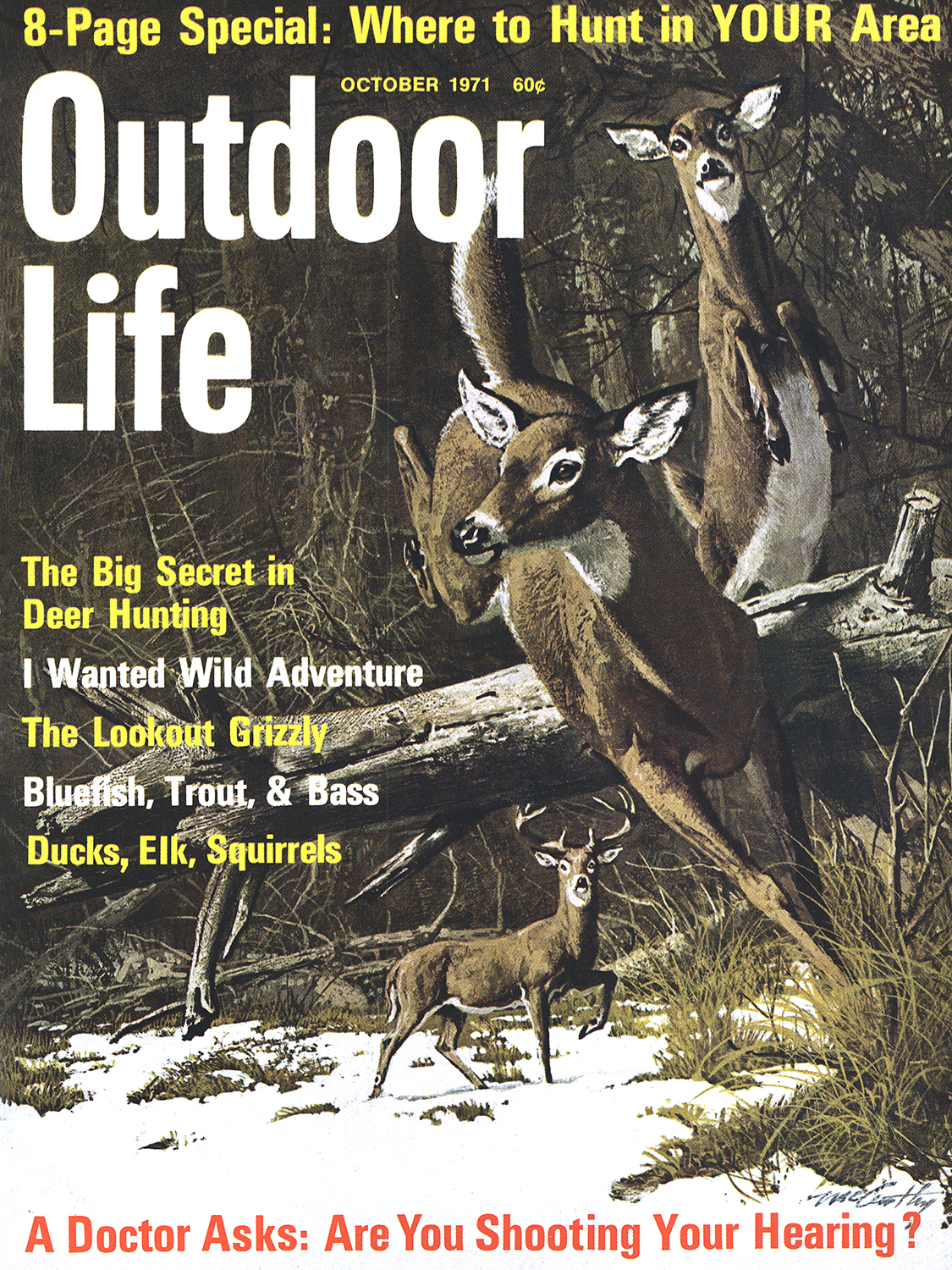
The guides knew their business. Nona was in the bow, Edouard was in the stern, and I was sitting on a blanket roll in the center. They quartered the canoe toward the moose, braked it with their paddles, and steadied it so that I could shoot.
I didn’t have much time to think. I just picked out the bull that seemed to have the best rack and cut loose when he was almost at the shore.
I got off four shots before he made it into the brush. The guides looked at each other.
“Missed!” Edouard said in a disappointed tone.
“I didn’t miss,” I said flatly. I had shot under handicaps—the excitement of trying for my first moose, the surprise, the cramped position in a canoe that was still moving, and the moving target going flat out—but I was certain that at least two of my shots had hit.
We beached the canoe and took the track. There was no blood, and after we had tracked the bull 300 yards through shoulder-high brush, Edouard and Nona shook their heads and started to turn back.
Suddenly the excitement and confusion cleared, and I realized what was wrong.
“We’re following the wrong bull,” I cried. “I shot the other one.”
We ran back to the shore, and the guides picked up the tracks of the second bull at the water’s edge. Fifty yards from shore in thick brush, Edouard pointed silently to a fleck of crimson on a leaf. Then there was more, and the flecks grew into bright patches. The men pulled up suddenly, and Edouard pointed ahead. A moose antler was sticking straight up out of the low cover.
We checked our rifles. The guides had a great deal of respect for a wounded bull moose or one in the rut. Then we walked up to him. There was no need for caution.
All four of my shots had connected. One had nicked an antler. One had hit low in the neck. Another had gone straight through the lungs, and the fourth had also gone through him, about eight inches farther back. None of the bullets had opened up as I had expected, and the exit holes were hardly bigger than the entrance wounds, but he was a very dead moose.
Nona went back to the post for a second canoe and the meat bags, while Edouard and I started skinning and dressing my kill.
It had all happened so fast that I could hardly believe it, and when we put a tape on the rack, I found that my first moose rack was a very respectable trophy with a spread of 58½ inches.
Moose hunting with a guide like Edouard was my dish, I told myself, and I had found the right place for it. Come another fall, I’d be back, I thought, and next month, I’ll tell you what happened on that hunt.
This text has been minimally edited to meet contemporary standards.
Read more OL+ stories.
